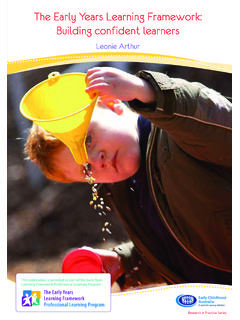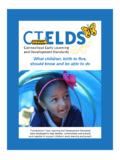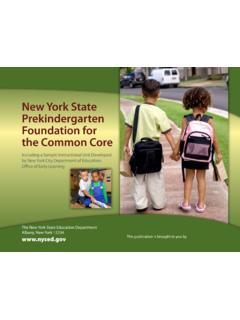Transcription of Quality Primary Education - UNICEF
1 Quality Primary Education :The Potential to Transform Society in a Single GenerationIn addition to being a right, basic Primary Education underpins the success of a society. Every year of Primary Education increases a person s productivity and reduces their dependence on social resources. The goal of Education is to enable childrento learn, realize their full potential, and participate meaningfully in society. In spite of increasing enrolment rates, too many children are learning far less than what they are taught about or what they ought to learn in school. This low learning achievement is most frequently due to a combination of factors that include inadequate learning environments, inappropriate teaching methods and frequently unmotivated teachers, and the malnourishment and ill-health of children themselves. Enhancing the Quality in Education , therefore, must be based on developing educational systems that are integrated and responsive to the multiple obstacles to children s learning.
2 Quality Education redresses gender and other inequalities; children s health and nutrition; issues of parental and community involvement; and the management of the Education system itself. The benefits and impact of Quality Education also make invaluable contributions to all areas of human development, improving the status of women and helping to alleviate and eventually eradicate Convention on the Rights of the Child (CRC) recognizes the right of every child to Education and requires States to provide free and compulsory basic Education (article 28). It further calls on governments to ensure that Education leads to the fullest possible development of each child s ability, and to respect children s parents cultural identity and for human rights (article 29). The CRC obligates both national governments and the international community to promote cooperation and ensure that the rights of children are met.
3 The World Conference on Education for All in Jomtien, Thailand sponsored by UNDP, UNESCO, UNICEF and the World Bank marked a significant shift in the world s collective approach to Education , broadening notions of Quality in basic Education and understanding its delivery focussing special attention on the world s poorest citizensIntroductionAccording to one World Bank study, every extra year of Primary Education increases a person s productivity (in this case hourly wage rate) by 10 to 30 percent1. Another study of thirteen low income countries found that four years of basic Education resulted in an 8 percent increase in farm production. Moreover a 10 percentage point increase in girls Primary enrolment is expected to decrease infant mortality by deaths per 10002. The high rate of return on Education clearly defines it as the surest way of breaking cycles of , Education had been assessed in terms of gross enrolment and completion rates at different levels.
4 The priorities were primarily on enabling increased access and enrolment. However, this was at the neglect of social access such as gender and family context, issues of high drop out and absenteeism, and if children were actually learning and retaining what they were taught. This concept of learning achievement has economic as well as educational implications. If class repetitions and drop-outs indicators of inefficiency and poor Quality can be reduced, limited resources will stretch much further. A survey of Latin American Education in the 1980s showed that, on average, a child took years to be promoted to the next grade and that each year 32 million students repeated grades in Primary and secondary schools, representing an annual waste of $ billion. Overall, low income countries spend on average four years worth more resources to produce a Primary school graduate than they would if there were no repeaters or drop outs4.
5 The poor Quality of Education deters children from attending schools5. Child labour experts have found that children would rather work than be subjected to a school regime that is irrelevant to their is an increased focus on the gap between what is taught and what is learned. A World Bank survey in Bangladesh for example found that four out of five of children who had completed five years of Primary schooling failed to attain a minimum learning achievement. A study of more than 60 countries on the Monitoring of Learning Achievement project revealed that only five per cent of Primary school pupils surpassed the minimum level of learning Primary Education1in their first three years. Evidence from Turkey, Sri Lanka, and the Philippines has shown that children who participate in early intervention programmes perform better in Primary school than those who do not benefit from formal early childhood programmes, and studies from Latin America, India, and Morocco demonstrate that disadvantaged children benefit the most from such programmes9.
6 Indeed, the overwhelming body of evidence shows that a child who is denied adequate stimulation and care or exposed to extreme stress during early childhood is likely to have difficulties with psychosocial development in later life. The Quality of ECD interventions is augmented by the consistent involvement of parents and caregivers in highly integrated learning achievement is rarely explained by one inadequate component or a single paucity in educational programming. Rather it is most frequently the result of many, often interrelated factors that signify a deficiency in educational systems. Children cannot learn if they are sick, and crammed into classrooms. Children will not learn if they are passive recipients of lessons delivered by ill-equipped teachers, if they do not apply their learning in supportive home and community environments. Moreover, educational systems cannot improve and develop without community acceptance and support, without resources and the simultaneous attention to how and what educational programming is developed and delivered.
7 Quality Education refers to a system of Education that through programming process, structure and content enables: Learners who are healthy, well-nourished, and ready to participate and learn, and supported in learning by their families and communities; Environments that are healthy, safe, protective and gender-sensitive, and provide adequate resources and facilities; Content that is reflected in relevant curricula and materials for the acquisition of basic skills, especially in the areas of literacy, numeracy and skills for life, and knowledge in such areas as gender, health, nutrition, HIV/AIDS prevention, and peace; Processes through which trained teachers use child-centred teaching approaches in well-managed classrooms and schools and skillful assessment to facilitate learning and reduce disparities; Outcomes that encompass knowledge, skills, and attitudes, and are linked to national goals for Education and positive participation in precise definitions of Quality are indeed varied according to the local educational contexts of different countries.
8 However, the distinction between simply implementing educational programmes and the commitment to ensure that they produce the desired learner outcomes is being tested in a series of novel programmes around the world. Existing lessons demonstrate that Quality educational systems can be realized through multifaceted strategies that promote: Quality learnersHealthy, well stimulated childrenQuite simply, children must be capable of attending school and learning. Hence they must be adequately nourished, stimulated physically and psychosocially and protected from preventable diseases and infection. Essential development that forms the basis for children s learning occurs during early childhood particularly 2 Quality Primary Education34 Supportive parents and familiesParents and families are the first teachers of a child. However, they may not possess the adequate knowledge on care during the early years, or be able to support children s schooling requirements in later years.
9 Children who s parents had Primary school Education or less are more than three times more likely to have low test scores and grade repetition than children who s parents who had secondary schooling10. Poorer and less educated parents are more likely to require assistance within the house, in farming or within a family run enterprise than parents with higher , developing a stimulating and enabling home environment can be pursued through the inclusion of parents in the Education process. The effects of schools in poor areas can often counterbalance the impact of a disadvantaged family background. One example is the creation of student newspapers in China. The result is that, much more than in other countries, pupils and parents have the possibility to read, which is of benefit in particular to otherwise disadvantaged rural families 11. Another important strategy for cultivating a supportive family and community environment for Education is to garner parental participation in school management.
10 This enables parents to learn, understand and contribute to both the content and process of Primary Education5 The support of schooling by parents and community members can be cultivated through creative programming that facilitates contact and collaboration on local issues. The Social Forestry, Education and Participation (SFEP) project in Thailand brought fifth and sixth grade students out of the classroom and into the community to learn about forest management. Students surveyed villagers to identify specific forest management problems and community members gradually became more involved as informal teachers. Together, they developed community projects, such as the care of seedlings or the establishment of a forest nature centre that helped students increase their knowledge of forest ecosystems and the social systems that surround them. Communities supported this new form of teaching and learning, and school-community relations improved.















